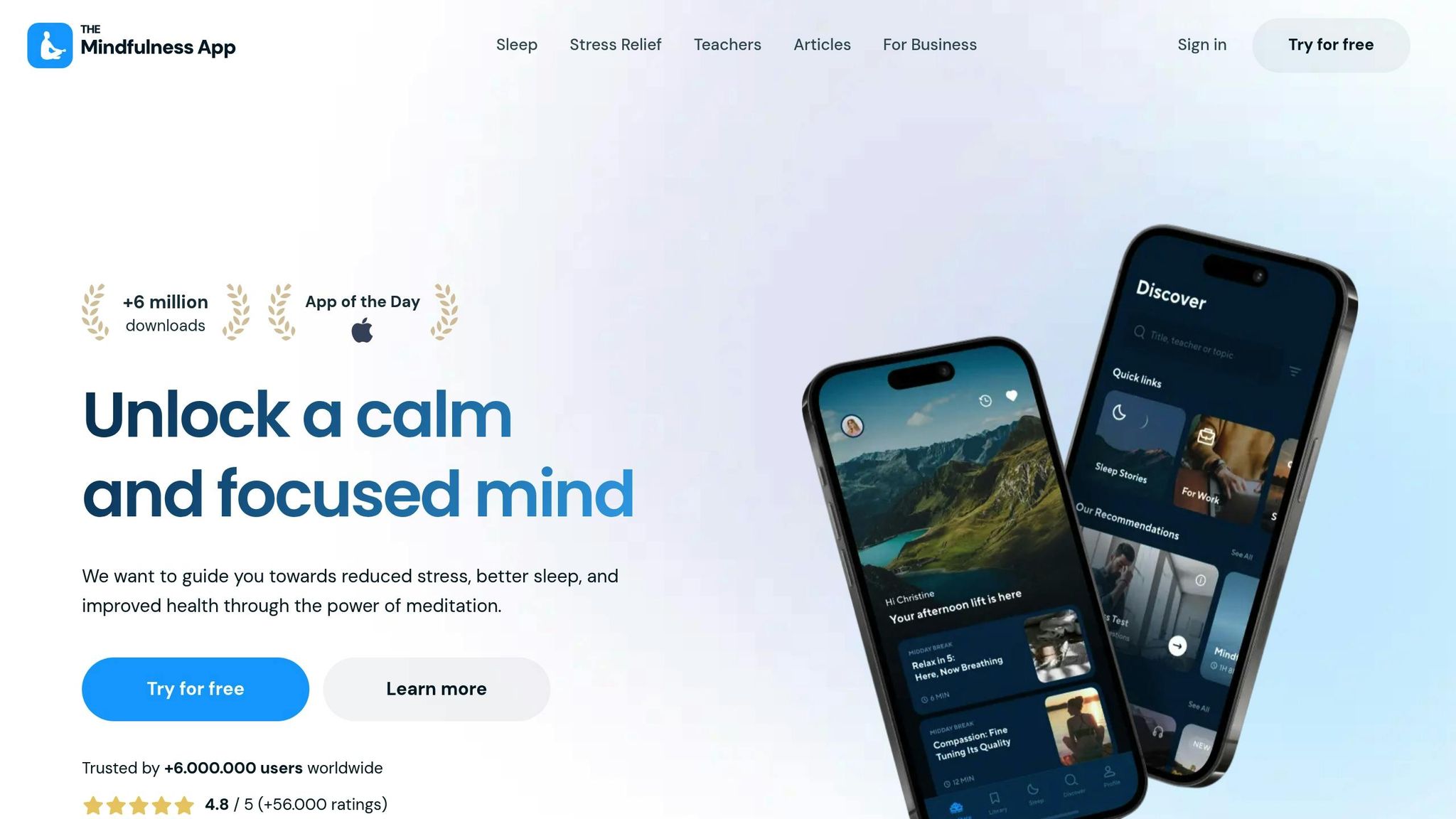Mindfulness at work is about staying focused, calm, and present during your tasks. It helps reduce stress, improve concentration, and boost productivity. Here’s how you can start:
- Mindful Breathing: Use techniques like the 4-7-8 method to reset between tasks or meetings.
- Single-Task Focus: Work on one task at a time with a timer, avoiding distractions.
- Body Scans: Notice physical tension and release it with small adjustments.
- Mindful Walking: Pay attention to your steps and surroundings during short walks.
- Mindful Meetings: Set intentions, listen actively, and take notes to stay engaged.
- Email Awareness: Check emails at set times and respond thoughtfully.
- Task Switching: Pause briefly between tasks to stay organized and clear-headed.
- Difficult Conversations: Take a breath, focus on facts, and respond thoughtfully.
Consistency is key - start with small, simple habits like a daily breathing practice or a mindful pause before emails. Tools like mindfulness apps can also help you integrate these practices into your routine.
Mindfulness at Work - 5 Mindfulness Desk Exercises
Simple Mindfulness Techniques for Your Workday
Bringing mindfulness into your workday doesn’t have to be complicated. These easy techniques can seamlessly blend into your routine, turning ordinary moments into opportunities for calm and focus.
Mindful Breathing Breaks
Taking just 60–180 seconds to focus on your breathing can do wonders for resetting your mindset. It’s a quick way to transition between tasks or shake off stress.
A great method to try is the 4-7-8 breathing technique: inhale for 4 counts, hold your breath for 7 counts, and exhale slowly for 8 counts. Repeat this cycle 3 to 4 times. This simple pattern triggers your body’s relaxation response, clearing mental clutter and easing tension.
Timing is key. Use these breathing breaks before important meetings to steady your nerves, after difficult phone calls to let go of frustration, or between big tasks to prevent stress from piling up. Even during your commute - whether you’re stuck in traffic or waiting for the subway - you can use this technique to stay centered.
Single-Task Focus Blocks
Multitasking drains your energy and lowers the quality of your work. Instead, try single-task focus blocks to stay mindful and productive.
Set a timer for 25 to 50 minutes and dedicate that time to just one task. Close unnecessary tabs, silence notifications, and put your phone away. If your thoughts stray to other projects or to-do lists, simply notice the distraction and gently bring your attention back to the task at hand.
After each focus block, take a short 3–5-minute break. Step away from your desk, stretch, or practice mindful breathing. These pauses help your brain process what you’ve accomplished and prepare for the next task, keeping you sharp and focused throughout the day.
Body Scan Check-Ins
Stress often manifests physically - tight shoulders, clenched jaws, or shallow breathing. A quick 2 to 5-minute body scan can help you tune in to these signs and release tension before it builds up.
Start at the top of your head and slowly move your attention downward, noticing any areas of tightness or discomfort. Are your shoulders hunched? Is your jaw clenched? Are you gripping your mouse too tightly? Don’t try to fix anything right away - just observe.
Once you’ve completed the scan, make small adjustments. Roll your shoulders back, relax your jaw, or sit up straighter. These minor tweaks might seem trivial, but they can prevent the physical stress that often leads to headaches, neck pain, or fatigue by the end of the day.
Mindful Walking Practices
Walking is something you do countless times a day, making it a perfect opportunity to practice mindfulness. Whether you’re heading to a meeting, the parking lot, or just taking a lap around the office, you can turn these moments into mindful pauses.
Pay attention to the physical sensations of walking - the feel of your feet hitting the ground, the rhythm of your steps, or the swing of your arms. If you’re outdoors, notice the temperature of the air or the sounds around you. This isn’t about walking slower or changing your pace; it’s about being present in the moment.
For longer walks, like a lunch break stroll, try syncing your breathing with your steps. For example, inhale over three steps and exhale over three steps, finding a rhythm that feels natural. This combination of movement and breath awareness can be especially grounding after hours in front of a screen.
Even a 30-second mindful walk to the printer or water cooler can act as a mini-reset, helping you return to your desk with a clearer mind and renewed focus for the tasks ahead.
Applying Mindfulness to Common Work Situations
Once you've grasped the basics of mindfulness, the next step is putting these practices to work in real-life situations. The workplace, with its constant demands and challenges, offers plenty of opportunities to use mindfulness to stay grounded and handle stress effectively. Let’s explore how mindfulness can help in specific scenarios.
Mindful Meetings
Meetings can quickly become overwhelming, especially if you're balancing tight deadlines or navigating tense discussions. Start by taking a moment to ground yourself. A simple 60-second breathing exercise can help you reset and focus.
Before diving into the agenda, set an intention for the meeting. This could be something as straightforward as, "I will listen actively," or "I’ll focus on contributing constructively." This small pause allows you to be fully present rather than preoccupied with what you’ll say next.
When the meeting begins, practice attentive listening. Pay close attention to the speaker’s words, tone, and body language. If your mind starts to wander - maybe to your inbox or an upcoming deadline - gently guide your focus back to the conversation. This kind of presence often leads to better insights, stronger collaboration, and more meaningful interactions.
For virtual meetings, keep a notepad handy. Use it to jot down distracting thoughts or ideas that pop up, so you can quickly refocus on the discussion. It’s a simple trick that keeps you engaged without losing track of important thoughts.
Mindful Email and Messaging
Email is one of the biggest sources of workplace stress, especially when your inbox feels endless or the messages are particularly demanding. To manage this, try checking emails at specific times - say, at 9:00 AM, 1:00 PM, and 4:00 PM - rather than constantly throughout the day. This reduces interruptions and helps you stay focused.
Before opening your inbox, take three deep breaths. This quick pause helps you approach your messages with a clear mind instead of reacting on autopilot. When a frustrating email lands, acknowledge your emotions. For example, if you feel annoyed, simply note it: "I’m feeling frustrated right now." Recognizing your emotions creates a gap between feeling and reacting, which allows you to respond more thoughtfully.
When drafting replies, take a moment to review your message before hitting send. Ask yourself: "Does this tone reflect what I want to communicate?" and "Am I responding to the actual content, or to my assumptions about it?" This brief reflection can help prevent misunderstandings and maintain professional relationships.
Task Switching with Awareness
Jumping from one task to another can scatter your focus and increase stress. Mindful transitions can help you close out one task and prepare for the next with greater clarity.
When you finish a task, take a moment to pause. Acknowledge what you’ve accomplished and note your next step, like "Review the project timeline" or "Follow up with Alex about the report." This simple habit keeps you from mentally holding onto unfinished tasks, which can drain your energy.
Before starting your next task, take another mindful breath and set a clear intention. Instead of diving in impulsively, ask yourself, "What’s the most important thing to focus on right now?" This quick ritual, which takes less than 30 seconds, can help you fully engage with the new task.
If an interruption pulls you away mid-task, don’t panic. Jot down your current thought or next step, then give your full attention to the interruption. When you return, you’ll know exactly where to pick up without wasting time trying to remember.
Difficult Conversations
Workplace conflicts - whether about performance, budgets, or team dynamics - can stir up strong emotions. A three-breath pause before responding can help you choose your words carefully instead of reacting in the heat of the moment.
During these conversations, grounding techniques can be incredibly helpful. For instance, focus on the feeling of your feet on the floor or the sensation of your breath. These small physical anchors keep you present and steady, even when emotions run high.
It’s also important to separate facts from interpretations. Instead of saying, "You always interrupt me in meetings," try something more neutral, like, "I noticed I was interrupted twice during today’s discussion." This approach minimizes defensiveness and keeps the conversation constructive.
If things start to escalate, don’t hesitate to pause. You might say, "Let me take a moment to think about that," or "I want to make sure I’m understanding your perspective." These phrases not only give you time to recalibrate but also show respect for the other person’s viewpoint.
sbb-itb-bea8dce
Setting Up Your Workspace and Schedule for Mindfulness
Creating an organized workspace and a thoughtful schedule can help you stay present and focused throughout the day. By making small adjustments to your environment and daily routine, you can support and deepen your mindfulness practice.
Designing a Calm Workspace
A tidy workspace can do wonders for your mental clarity. Start by clearing away unnecessary items that might distract you. A clean desk allows you to focus more effectively on the task at hand.
Make your workspace comfortable and ergonomic. Adjust your chair, desk, and monitor to encourage good posture and reduce physical strain. If possible, position your desk near a window to take advantage of natural light, which can help improve your mood and alertness.
Consider keeping a small object, like a smooth stone or a plant, on your desk as a mindfulness anchor. When you feel your focus drifting, touching or looking at this object can serve as a gentle reminder to pause and center yourself.
Structuring Your Day with Mindfulness in Mind
Mindfulness isn't just about meditation - it can also shape how you plan your day. Start by identifying when you're most focused and alert, and reserve those peak hours for tasks that require deep concentration.
Incorporate short mindfulness breaks into your schedule. A few minutes of deep breathing or a quick body scan between tasks can help you transition smoothly and maintain your focus. If your day is packed with meetings, try to schedule brief buffer periods to pause, take a breath, and reset before diving into the next conversation.
To avoid distractions, set aside specific times for tasks like checking emails, tackling administrative work, or engaging in focused, uninterrupted work sessions.
Creating Quiet Spaces for Mindfulness
Even in a bustling office, you can often find pockets of quiet for mindfulness. Look for unused meeting rooms or wellness spaces where you can spend a few minutes meditating or practicing breathing exercises. If your workplace doesn’t have dedicated quiet areas, consider proposing a wellness initiative like a quiet zone or meditation room to support everyone’s well-being.
If no quiet space is available, you can still practice mindfulness at your desk. Simple techniques like focusing on your breath, scanning your body for tension, or listening to ambient sounds can help you stay grounded without disrupting others.
For a change of scenery, step outside. Nearby parks, courtyards, or even a quiet corner of the parking lot can provide a refreshing break. A short walk around the building can combine physical movement with mindfulness, recharging both your body and mind.
Remote workers can designate a specific area at home as their mindfulness space. It doesn’t have to be elaborate - a comfortable chair by a window or a cozy cushion in a quiet corner works just fine. Using the same spot consistently can help signal to your brain that it’s time to shift into a mindful state.
Using The Mindfulness App for Workplace Wellness

In the fast-paced world of modern work, finding time for mindfulness can feel like a luxury. That’s where technology steps in. The Mindfulness App is designed to help you incorporate mindfulness into your daily professional routine - whether you’re at your desk, heading into a meeting, or traveling for business.
Guided Meditations and Practical Tools
The Mindfulness App offers a variety of guided meditations, ranging from quick 3-minute sessions to longer ones over 30 minutes. For busy workdays, the shorter sessions can easily fit into your schedule without causing interruptions.
One standout feature is the customizable meditation timer with interval bells. This tool is perfect for structuring focused work periods. Set the timer to your preferred duration, and let the gentle chimes signal mindful breaks, helping you maintain focus during long stretches of work.
Need a quick mental reset? The body scan meditations are a great option. A short 5-minute session after a stressful meeting can help you release tension and refocus before diving into your next task.
For those moments between meetings or tasks, the app’s breathing exercises are a lifesaver. A simple 2–3 minute breathing session can help you clear your mind before tackling your inbox or transitioning to the next project.
Creating a Daily Mindfulness Routine
The app is designed to help you establish a consistent mindfulness routine. You can build a 14-day schedule that includes brief sessions in the morning, midday, and evening. To stay on track, set reminders for key times during the day - like 9:00 a.m., 12:00 p.m., 3:00 p.m., and 6:00 p.m. - to prompt quick mindfulness practices. Keep these reminders specific, such as “3-min breathing before emails,” to make them actionable.
If you use Apple Health, the app syncs your Mindful Minutes automatically. This feature allows you to monitor your progress, track consistency, and stay motivated with streak tracking and wellness data.
Staying Mindful Anywhere with Offline Access
The Mindfulness App’s offline functionality ensures your mindfulness practice doesn’t skip a beat, even when you’re without internet access. Pre-download short, audio-only guided sessions for times when connectivity is limited, like during flights or commutes.
For frequent business travelers, this feature is especially useful. Download a 3-minute “SOS” track to calm your nerves before high-pressure meetings or challenging conversations. These quick sessions can help you reduce stress and stay grounded in critical moments.
Even for those working remotely or in hybrid setups, offline access is a game-changer. By downloading weekly sessions, you can ensure that connectivity issues won’t disrupt your mindfulness practice. These features make it easy to weave mindfulness into any work scenario, no matter where you are.
Getting Started with Workplace Mindfulness
Key Takeaways
Workplace mindfulness involves bringing purposeful awareness to your daily tasks. Techniques like mindful breathing or setting focused work blocks can help ease stress, improve concentration, and manage emotions when faced with demanding situations.
For example, practicing mindful breathing before diving into your inbox trains your brain to approach tasks calmly and thoughtfully rather than reacting impulsively. Similarly, quick body scans can break the cycle of stress buildup, offering a moment to reset.
It's all about consistency. Short, regular sessions - just two minutes a day - are far more effective than infrequent, lengthy practices. The aim is to develop habits that enhance both your work performance and overall well-being.
Your First Steps
With these principles in mind, here’s how you can start weaving mindfulness into your workday:
Begin with one simple habit and stick to it for a week before adding more. This gradual approach makes it easier to create a lasting routine. For instance, if your schedule is packed with back-to-back meetings, try a 30-second body scan between them. Pause for a moment, take three deep breaths, and notice areas of tension, like your shoulders or jaw. Even this small practice can help you stay grounded throughout the day.
To make mindfulness easier, consider using tools like The Mindfulness App. Start with their 3-minute guided sessions, which are perfect for beginners. Use the app’s customizable timer to create focused work intervals, and set a daily reminder - like a quick midday reset at 12:00 p.m. - to keep your practice on track. Small steps like these can make a big difference in how you navigate your workday.
FAQs
How can I easily practice mindfulness at work without adding extra stress?
Incorporating mindfulness into a packed workday doesn’t have to be complicated. Simple, intentional practices can make a big difference. For instance, take a couple of minutes between tasks for mindful breathing. Focus on slow, deep breaths to help you reset and stay present as you move through your day.
Another idea is to build in short mindful breaks. Step away from your desk for a quick stretch or a moment of quiet reflection. Setting reminders to pause and check in with yourself can make these moments feel natural, not forced.
If you’re looking for extra guidance, tools like The Mindfulness App can walk you through quick exercises designed to boost focus and relaxation. These practices fit effortlessly into your day, helping you stay grounded without adding stress.
How can I stay mindful during virtual meetings?
Staying mindful during virtual meetings is a great way to stay focused and engaged. Start by actively listening - give the speaker your full attention and try to maintain eye contact through the camera. This small effort can help create a sense of connection, even in a virtual setting. To keep yourself grounded, pay attention to your breathing. Slow, deep breaths can work wonders - try counting each inhale and exhale to help center your thoughts.
Before the meeting kicks off, take a moment to check in with yourself. How are you feeling? Setting a simple intention, like staying calm or being fully present, can help guide your mindset. Once the meeting is underway, resist the urge to multitask. If your mind starts to drift, gently pull your focus back to the discussion. These mindful habits can make virtual meetings feel more engaging and far less overwhelming.
How can mindfulness help with communication and stress during tough workplace conversations?
Mindfulness can play a key role in navigating tough workplace conversations. It helps you remain calm, focused, and fully present, even in challenging moments. Simple techniques like mindful breathing or brief meditations can ease stress and keep emotional reactions in check. This allows you to approach the discussion with a clearer, more balanced mindset.
Another powerful tool is mindful listening. This means giving your full attention to the speaker, without jumping to conclusions or passing judgment. It fosters understanding and empathy, paving the way for more respectful and productive exchanges. By staying grounded in the moment, you can respond thoughtfully instead of reacting on impulse, ultimately leading to better outcomes for everyone involved.






